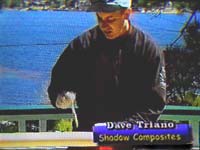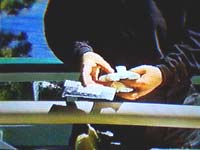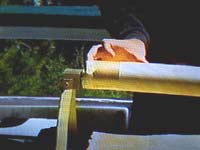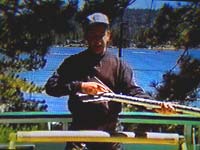Shadow Composites Advanced Composite Techniques Video
Shadow Composites - Advanced Composite Techniques Video {Video}
Contributed by Darrell Mobley
| Manufacturer: | Shadow Composites |
This review is provided courtesy of:

Shadow Composites' composite construction video a must-have!
 Dave Triano of Shadow Composites showing epoxy application techniques on the video. |
With the Winter building season in full swing for most rocketeers across North America, this is the time of sawdust, sandpaper and epoxied fingertips. Tucked away in basements, garages and spare bedrooms, rocketry enthusiasts are busy preparing and/or repairing their fleet for the first touch of green that signals the Spring flying season is officially back open.
One of the areas of rocket construction that offers the most reward for the least amount of investment is also an area that offers the most confusion -- composite reinforcing of a rocket airframe. Composite reinforcement, or as it's commonly called, "fiberglassing", is one of the single most important things a rocketeer can decide to do to increase the strength and longevity of their rockets. But because there is somewhat of an art to composite reinforcing, many rocketeers are nervous to even attempt the work, fearing a failed attempt would destroy their project.
 Shadow Composites offers a full line of thickening amendments for fillet building. |
Thankfully, there is someone who can help, and that someone is Shadow Composites from South Lake Tahoe, California. The proprietor of Shadow Composites, Dave Triano, has put together the Holy Grail of composite construction information in one easy to understand VHS video tape called "Advanced Composite Techniques for High Power Rocketry - Volume 1 - The Basics".
The 1 hour, 41 minute video contains a complete ground-up instructional on advanced composite materials, their proper use in a rocketry context, and demonstrations on the correct tube lamination techniques for glass, carbon fiber, and Kevlar®. You will also learn about a neat technique called "Heat Tape Winding", a technique that can give you vacuum bagged quality composite structures at a fraction of the cost, time, and equipment investment normally associated with vacuum bagging!
 Proper setup for an accurate layup process is outlined in clear detail on the video. |
Dave's 20 years of experience in composite construction is easily transferred during a viewing of the video, and leaves you wanting to run right out into your shop and give the techniques a try. If you are tired of building and then repairing and repairing and repairing paper rockets, and you have been thinking about using composite construction, this video is for you!
The video covers traditional fiberglass, including the differences in e-glass and s-glass, carbon fiber and Kevlar® cloths. It goes into detail about the different techniques in cloth production and weave patterns. The technique for using their line of heat shrink tape to squeeze excess resin from the layup was especially beneficial. And, unless you think composite construction is only for high power rockets, there is a whole segment for competition flyers -- on building ultra-lightweight competition rockets with carbon fiber and fiberglass matte.
 Dave even covers some of the strong points of their carbon-fiber RAVEN product. |
The video is a bargain priced at $25.00 but for those of you who are interested in a special deal, they will throw in one roll of their specially formulated "Heat Tape" as used in the demonstrations for just $38.00. The Heat Tape alone normally runs $16.00 per 100 yard roll, enough to wrap over fifteen 3" by 36" airframe tubes.
This video is highly recommended and appears to be the first in what promises to be a great series. To order, send payment (plus 7.75% Sales tax in CA.) to: Written and submitted by Darrell D. Mobley for Rocketry Online -- Copyright 1996-1999 Shadow Composites, Inc.
International orders please email shdwcmp@sierra.net for a shipping quote, Canada orders add $3.00 for standard postage. They accept money orders or personal checks but no credit card orders.
260 Dover Dr.
South Lake Tahoe, CA, 96150
Additional Reviews:
What Shadow Composites Says . . .
Shadow Composites, Inc. is proud to announce the release of a very special video - "Advanced Composite Techniques for High Power Rocketry - Volume 1 - The Basics".
The 1 hour, 41 minute video contains a complete ground-up instruction on advanced composite materials, their proper use in a rocketry context, and demonstrations on the correct tube lamination techniques for glass, carbon fiber, and Kevlar. You will also learn about our revolutionary "Heat Tape Winding" technique which gives you vacuum bagged quality composite structures at a fraction of the cost, time, and equipment investment of vacuum bagging! If you are tired of creating "disposable" paper rockets and you have been thinking about using advanced composites to create bulletproof rockets, this video will save you a HUGE amount of time and money! We have over 20 years experience in the manufacture of advanced composite structures for aerospace use, and this video will start you on your way to flying with REAL rocket science! Also shown is a special segment for you NAR COMPETITION FLYERS - How to create an ultra-light carbon fiber 10.5 mm. competition airframe! A vendor and supplier list of all recommended materials used in the video is included! What Viewers Say . . . It was also extremely surprising on how easy Dave made it look. I lost count, but he must have built 6 - 7 tubes within that 1 hour 41 minute video. Makes me think I could do it too! Also, he explained himself well and described the techniques and materials with detail to answer the many questions people are likely to have. This would be a type of video that one would watch over and over to ensure they are following the same techniques and possibly have it on while wrapping your own tube. The video lighting and quality allow for easy viewing. There were also enough close-ups to see specific material and results. Not being skilled in the area of composites or even fiberglassing tubes, I can't comment on its accuracy, however, everything presented was logical and backed by the demonstrations. I would recommend this video to those that even have the slightest interest in working with composites, that way you can find out what you would be getting into. - Nick from EMRR Jerry O'Sullivan says: The Shadow Composites "Advanced Composites Techniques" video makes no assumption of the experience level of the viewer and so begins with a thorough discussion of what an "aerospace composite structure" is. The narrator, Dave Triano, then goes on to discuss the properties of the different materials, a demonstration of cloth weave varieties, and a review of resin materials available. It then proceeds through actual application of fiberglass, carbon fiber, and Kevlar cloth materials on rocket body tubes in a leisurely fashion, giving technique pointers along the way. You'll learn how to set up your work surface, make a stand to hold the airframe, select the proper safety and application materials, and in one segment, how to make an ultralight all-composite airframe. I found the tape to be useful, thorough and informative even though I'd had experience fiberglassing rockets before. A "heat tape winding" method interested me as a way to squeeze out excess resin while at the same time further compressing the cloth to the body tube. Vacuum bagging results without the hassle! I'm looking forward to a promised follow-up video in this series which will cover vacuum bagging and other advanced techniques. Summary: Overall Rating: 5 out of 5
I watched the video with no interest in using composites to build tubes. I am a "kit" person, as one would imagine the webmaster of this site to be. However, several areas piqued my interest. I found it very interesting how Dave describes the different materials and their pro's and con's. It was especially interesting to me on how the tube winding direction really establishes the strength of the tube from different pressure directions. A tube that he showed, was wound one direction for the inner layer, laterally for the middle layer and then the opposite direction for the outer layer. This method producing a very strong tube.
An instructive and informative video that anyone interested in composites or fiberglassing would benefit from.
 |
 |